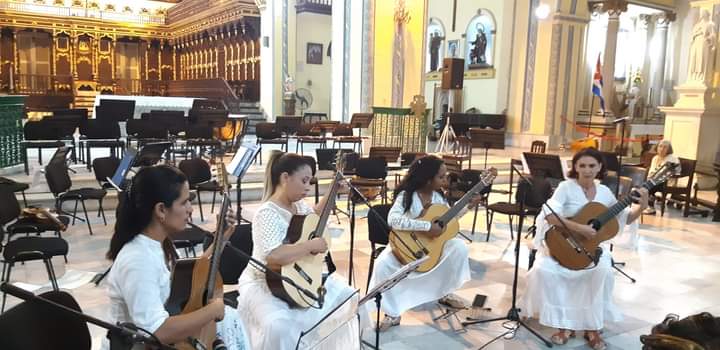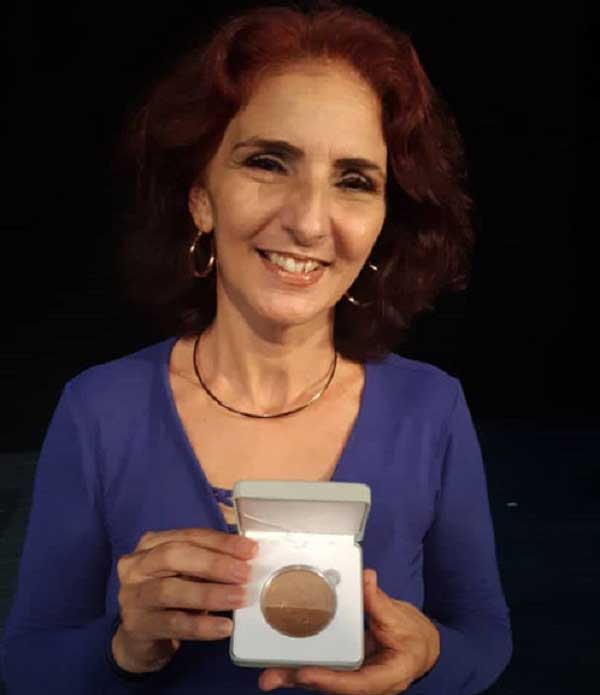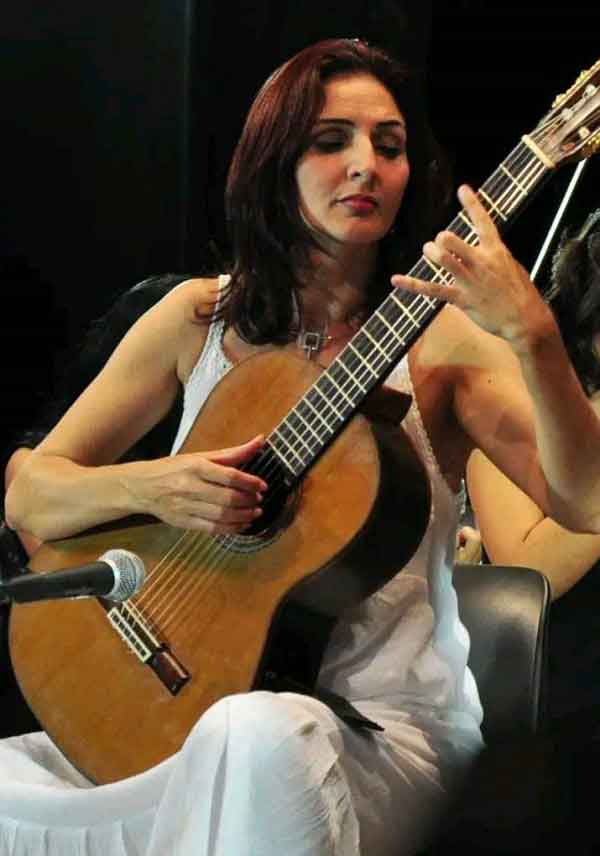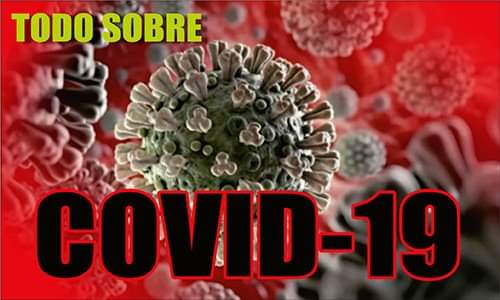
She is -without a doubt- one of the best-known guitarists in the country. We often see her walking with her guitar on her back through the streets of Las Tunas, her adopted city; although she has been seen in other Cuban provinces defending classical music. She was recently awarded the 50 Aniversario de la Nueva Trova Commemorative Medal. Let us learn more about this concert guitarist and her endeavors.
• You are a concert guitarist, why then conduct a club, for almost nine years, where you incorporate Trova and Nueva Trova?
 First, because the host of the club is not the nueva trova, but the guitar; that's what I like to say. That's why I start each meeting with a piece from the concert repertoire for that instrument, as an illustration. It is something didactic and a way of presenting who I am at a professional level.
First, because the host of the club is not the nueva trova, but the guitar; that's what I like to say. That's why I start each meeting with a piece from the concert repertoire for that instrument, as an illustration. It is something didactic and a way of presenting who I am at a professional level.
Secondly, it is the Asociación Hermanos Saíz (AHS by its acronym in Spanish) in Las Tunas that invited me to have a space in their headquarters. Therefore, I owe myself to their artistic and aesthetic interests. In this case, as they have many troubadours in their music branch, that was the initial purpose.
Thirdly, because I am not discovering trova now. The new trova has always accompanied me (the new and the old). Since I was very young I used to learn the songs and sing them for myself, a personal enjoyment that I shared with colleagues and friends.
• Tell me about the first time you arranged Nueva Trova songs for concert guitar.
It was at the request of Jesús Ortega. At that time I was the lead guitarist and vice director of the guitar orchestra "Sonantas Habaneras", of which I was the founder and member for fourteen years.
That maestro had a concert pending at the Instituto Superior de Arte (ISA in Spanish), an award ceremony for cultural personalities. He had been asked to play a repertoire of the new trova because Silvio Rodríguez and Pablo Milanés would be present at the event. He, who knew that I liked trova, told me why I didn’t do it, that I was the most suitable. I told him that I had never done that and I could be wrong, but he replied that I should do it and that he would help me and review it.
I am eternally grateful to him. From there what I did was select two songs from each one, and look for the songs (if I learned anything it was to arrange the original song). I did everything by hand. At that time I didn't have a computer, much less the programs that exist today to write music. I did it all by hand on lined paper and with a Walkman. I recorded a piece, let's say the harmony, and from there I wrote it down and recorded each voice.
Then I would go to the teacher's house, which had a computer and the Encore program. He would transfer to the computer, note by note, what I dictated to him from my arrangements. When the transcription was finished, he would listen to what I had written.
The event took place at the Instituto Superior de Arte (ISA). I remember that Silvio Rodríguez, Sara González, Santiago Feliú, and Harold Gramatges, among many others, were there. The photographs are still preserved. It was a memorable day. As time has gone by, I have realized, even more, how important it was for me to have made the arrangements that were premiered for that important audience.
• You have been working with troubadours and new trova music for more than 20 years. What attracts or motivates you to make arrangements for this genre?
It is precisely the respect I have for this genre and these authors, for the people who inspired or motivated these songs. It is a pleasure to interpret and arrange them in a format to share them with the public.
It motivates me -also- because it is not a genre I know now. When I was a student, there were seven guitar students in my class and I was the only female. I remember that, in the free shifts, we used to sing. Those boys sang songs of the new trova and so I began to learn them and sing them with them. The literary aesthetics of these songs have always caught my attention. They are different points of view and profiles.
The Nueva Trova is an extension of myself. My training is instrumental and making songs of this type makes me reach a little further, to have direct access to a repertoire that is not the one I am used to. So that's what it is, a way to reach that repertoire and grow musically, artistically, and sentimentally. The arrangements I have made are of songs that have great meaning for me, that speak of things I need to express.
• "Mujer que sueña Guitarras" is a phonogram nominated for the Cubadisco 2023 Award in the Instrumental category. This is an album recorded by four women, in four sections and with four works per section. The last section is your arrangements of new trova songs. Tell me about it, what motivated you to insert this section as the closing of the album?
The phonogram Mujer que sueña Guitarras is made up of 16 works, all of them with my arrangements. There are four sections, each one composed of four works. The first block is made up of works from the 19th century, originals for piano. This is our letter of introduction: the Cuban national identity; precisely with the creators of Cuban musical nationalism: Manuel Saumell and Ignacio Cervantes.
The second block is made up of works by José María and Sergio Vitier. They are works of Cuban cinema and television, because of the impact they have had on our country at an emotional and historical level. The third block is made up of works from the Latin American repertoire. They are pieces from four different countries: Mexico, Venezuela, Paraguay, and Brazil. It is a window to the world, a salute to the music of other countries from my vision as a guitarist and as a woman concert pianist.
The last block is made up of four works, four icons of the new trova, and four different authors. Besides, they are songs with women's names; a little representative of us, the members of the album: Giovanna, Claudia vendrá, Giselle, and Para Bárbara.
• You have made many collaborations with first-level troubadours throughout your career, why do you think this is? What do you think is the reason why they call you for these works?
 For quite some time I have been collaborating with performers of the new trova. When I was a student at the Amadeo Roldán Conservatory, the school choir and I, playing guitar, were summoned to accompany Teresita Fernández in what is today the Cuban Institute of Music. That was my first experience accompanying a troubadour: precisely Teresita Fernández.
For quite some time I have been collaborating with performers of the new trova. When I was a student at the Amadeo Roldán Conservatory, the school choir and I, playing guitar, were summoned to accompany Teresita Fernández in what is today the Cuban Institute of Music. That was my first experience accompanying a troubadour: precisely Teresita Fernández.
Around 2003 I had the opportunity to meet Silvio Alejandro Rodríguez, Inti Santana, and Yosvani Bernal, who invited me to accompany them in their concerts. In the case of Silvio Alejandro and Inti Santana, the concerts took place at the Pablo de la Torriente Brau Center and were recorded to be part of a phonogram. Yosvani Bernal invited me to his concert at the Thalia Hall of the University of Havana.
From there to here, troubadours like Raul Torres and Ariel Barreiros asked me to accompany them in concerts here in Las Tunas. Among the younger ones are Iraida Williams, Jesus Ricardo Perez Cecilia, and Amaury del Rio, both in their peñas and in mine, we have made several collaborations.
I think they ask me to do this given the experience I have at the guitar level, as well as the technical interpretative mastery from the concert guitar, which gives a very complete result, in addition to contemplating their songs from the vision of a classical guitar.
• In general, first-level artists, from the catalog of excellence in music, such as you and the guitar quartet "Sultasto", seek to collaborate with other artists of their level. Although you have shared professionally with several of the best musicians in this country, you are not limited to that. You hold a monthly club at Las Tunas' venue, which has sheltered young troubadours (Amaury del Río, Ali Abigaíl, Martha Borrell...), including students from the country's art schools and writers, established or not. Why do you do that? Why with and together with young people?
Rudyard Kipling wrote, "Youth is not a stage of life, it is a state of mind". Youth is contagious. I have worked not only with young people but with writers and troubadours who are older than I am. Art does not grow old, but on the contrary, art grows, it grows in all senses the more time passes because it affirms itself. When it is an authentic art, it reaffirms itself.
In my spaces, I like to have collaborations with young people and with professionals. Especially for the former it is an opportunity to introduce themselves, share, and learn. Many of them have had their first time in public in my peña Del sueño a la poesía and, from there, I have seen them grow. For me, it is a vote of confidence, a gift I give them, while for the public it is an opportunity to discover a new performer. It is precisely from there that other presentations have come out. In other words, it is a vocation of service that remains with me as a performer and teacher.
• Recently, as a soloist and with the guitar quartet "Sultasto" you performed concerts in Havana and collaborated with prestigious troubadours and writers. In addition, they performed your arrangements in the presence of songwriters. Tell me about that.
This year I had the opportunity to resume my concerts in other provinces because due to the pandemic, there was a general recess in the country. I am happy because I was invited with the quartet to the festival "Guitarras en Santiago", where I gave master classes and presentations at the music conservatory Esteban Salas. I also performed at the headquarters of the Union of Writers and Artists of Cuba there and at the Cathedral of Santiago de Cuba. Then I was in the festival "A tempo con Caturla", in Santa Clara, a meeting that takes place annually in this city, dedicated to concert music.
Then, I was in Havana where I made six presentations. I was able to make, from concerts in "La Madriguera", in the "Patio de la EGREM", to concerts in the Pabellón Cuba, headquarters of the national AHS and, especially, in the Casa del Alba Cultural, invited by Maestro Jesús Ortega. He was my teacher, the great master of the guitar in Cuba, the master of all masters. For me, it was a challenge and an equal gift for him. To play, after so many years of graduation and that he dedicated listening to me, together with his students and members of "Sonantas Habaneras"..., a joy. I also made a presentation in Mayabeque, invited to the concert of Inti Santana, where I shared, also with writers.
The most important thing is that, to continue working and studying. The musician, like the writer, the plastic artist, and other creators, never rests because the mind does not rest. As long as the mind is active and the heart is on, we will always be dreaming works, dreaming things that come true when in contact with the public.
Certainly, I have had the opportunity to play my arrangements in front of the authors, as is the case of Pepe Ordás, Raúl Torres, Eduardo Sosa, and Gerardo Alfonso. Particularly the latter two were present at one of the concerts we performed at the Pabellón Cuba in Havana with the guitar quartet Sultasto.
It was very nice because, while we played the arrangements of their songs for instrumental music, they were very quietly singing the songs. In Gerardo's case, when we played his song, Giovanna, I was very moved to hear his voice singing softly while he played the melodic line of the piece. It was very, very moving for us, and for them too. They were impressed, they expressed it to us and they want to do collaborations with us.
In total, I have more than 30 arrangements of new trova songs, and many of them have been heard by their authors.
• You come from classical music and you insert it into trova, popular music. Do you advise concert performers to approach these musical genres? Do you think troubadours should do the same with classical music and classical guitar?
Before me, other performers of classical music or concert music did wonderful work with the troubadours. I remember Hernán López-Nussa accompanying Miriam Ramos singing songs by Noel Nicola; Frank Fernández with his wonderful arrangements of Unicornio and Melancolía, by Silvio Rodríguez. Frank's wife, an excellent cellist, is accompanying him on Unicornio. In the case of Pablo Milanés, his group was made up of excellent performers: Dagoberto González on violin and Miguelito Núñez on piano. They are great interpreters of their instruments who approached the repertoire of classical music. In other words, the technical and interpretative base was guaranteed.
Yes, I think that for the troubadours it has been a growth. Through their work they get these great interpreters of instruments such as the guitar, the violin, or the piano to do their version of these songs. Both grow: the author with a new projection of his work and the musician, because (as I said before) he approaches a repertoire that is not the usual one. Beautiful things come out of it.
• What does the new trova represent for Elvira Skourtis as a musician and as a Cuban?
For me, trova represents a lot, because it allows me to play new works and new repertoires, and, although many minimize it by seeing it as "popular", it is not so. It has been proven that a song, which already has a text, is more direct and accurate. Classical music has other requirements, it must be listened to more attentively, with greater silence, and knowing its codes of interpretation.
Besides, trova is part of everything, there is no history of Cuban music without trova; and as a Cuban, even more so; because, the repertoire of our songbook is wide, but I believe that the most significant and transcendent messages are in trova. There are other well-known genres, but it is the one that has the greatest weight. Maybe that's why I also approach it because I need it and it feeds me.
• Last June 24 you received the medal for the 50th Anniversary of the Foundation of the New Trova Movement, for more than twenty years working with troubadours and arranging songs by these authors. You received recognition together with musicians from your province such as Iraida Williams, Guislaine Ochoa, Jesús Ricardo Pérez Cecilia, among others, and especially with maestro Delfín Ramos, who is considered one of the most significant troubadours of the province, according to the words of Pablo Milanés. What does that mean to you?
It is a great challenge to be part of the list of people decorated with that medal because it has been awarded to other great musicians, performers, and personalities of music in Cuba, a select group that I am honored to be part of. It has been something very nice. What I felt, on a personal level, when I received the case, opened it and took out the medal, caressed it, and found a little guitar on the back, I can't describe how much joy I felt. Besides, it is a commitment to be a better musician and person.
• What are those dreams to fulfill?
When I was a child my dream was to play in a theater and I always visualized it with the audience standing and applauding. I have achieved that, in fact, on several occasions in Cuba and abroad.
I have dreamed of accompanying great performers and it is also a dream. Raúl Torres was one of them. I dreamed of accompanying Pablo and I accompany him now from another dimension.
The main dream, artistically speaking, is to move those who listen to me, it is what I feel when I express myself musically, a phenomenon that is generated from the moment the piece arrives, I learn it, memorize it and work on it..., I try to make it arrive in the same way at the moment of interpreting it, when I can be moved by the intensity of the sonorous message, something incredible.
It has happened to me on numerous occasions that when I have been playing and finished the piece, I have seen the audience in tears, moved. It happened to me with the composer Ñico Rojas after playing his piece Lilian, dedicated to his deceased daughter. When I finished, he and his wife came up to me, hugged me, and were shaking. That is one of the most shocking things that have happened to me in my life, to feel so close to the emotion and the trembling in the hand that greets me and thanks me.





